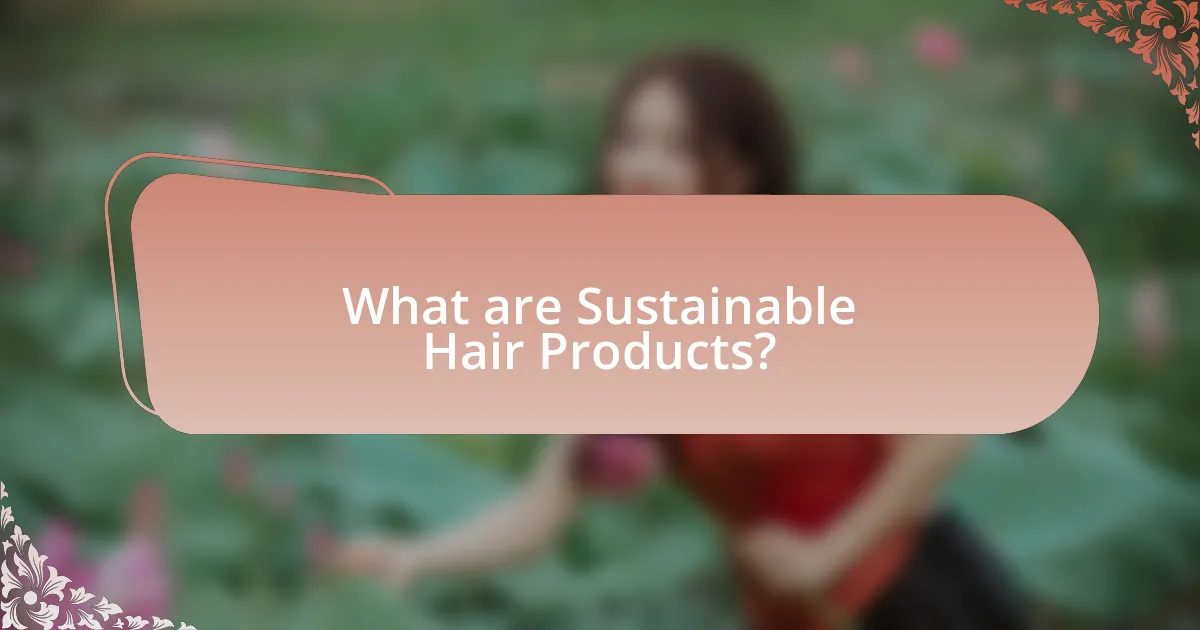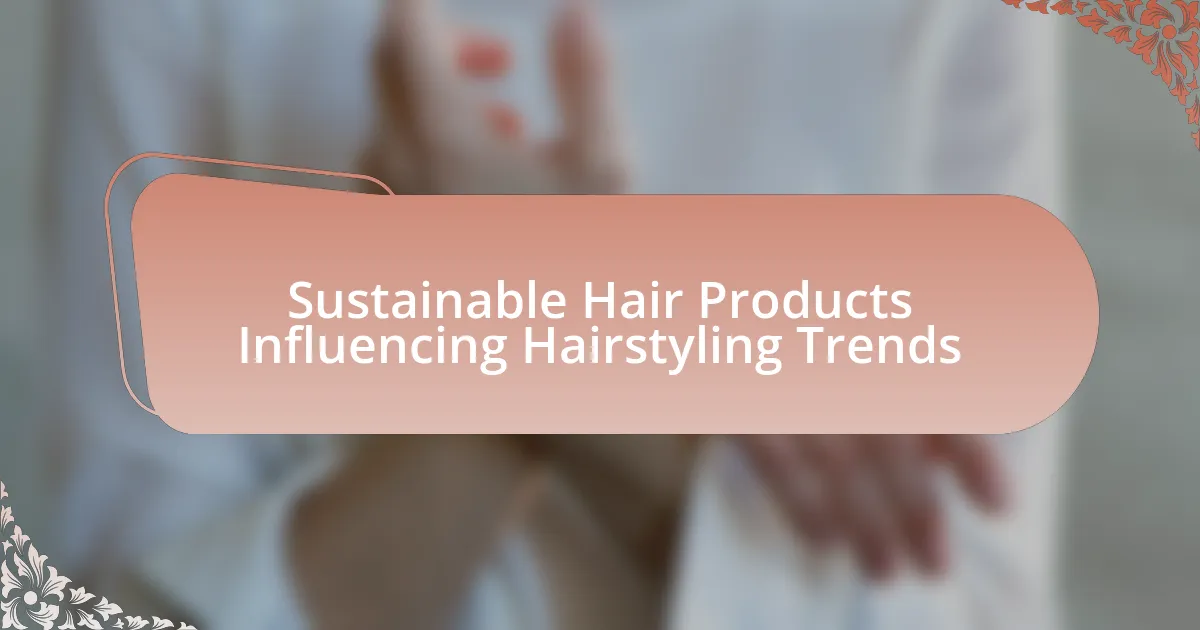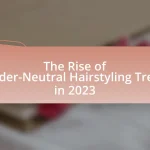Sustainable hair products are eco-friendly hair care items formulated with natural, biodegradable ingredients and packaged in recyclable materials, aimed at minimizing environmental harm. This article explores the differences between sustainable and traditional hair products, highlighting the benefits of natural ingredients and eco-friendly practices. It discusses the impact of consumer demand on sustainability in the hair care industry, emerging hairstyling trends influenced by sustainable products, and the challenges these products face in the market. Additionally, it examines the role of education and effective marketing strategies in promoting sustainable hair care options, ultimately emphasizing the importance of sustainability in shaping modern hairstyling practices.

What are Sustainable Hair Products?
Sustainable hair products are hair care items formulated with environmentally friendly ingredients and practices that minimize harm to the planet. These products often utilize natural, biodegradable components, avoid harmful chemicals, and are packaged in recyclable or compostable materials. For instance, brands like Aveda and Ethique emphasize sustainability by sourcing ingredients responsibly and reducing plastic waste, aligning with the growing consumer demand for eco-conscious beauty solutions.
How do sustainable hair products differ from traditional hair products?
Sustainable hair products differ from traditional hair products primarily in their formulation and environmental impact. Sustainable hair products utilize natural, biodegradable ingredients and avoid harmful chemicals such as sulfates, parabens, and synthetic fragrances, which are commonly found in traditional products. For example, a study published in the Journal of Cleaner Production highlights that sustainable products often incorporate plant-based ingredients that are less harmful to both human health and the environment. Additionally, sustainable hair products typically employ eco-friendly packaging, reducing plastic waste, while traditional hair products often rely on non-recyclable materials. This distinction not only reflects a commitment to environmental responsibility but also aligns with the growing consumer demand for ethical and sustainable beauty choices.
What ingredients are commonly found in sustainable hair products?
Common ingredients found in sustainable hair products include natural oils, plant-based extracts, and biodegradable surfactants. Natural oils such as argan oil and coconut oil provide moisture and nourishment without harmful chemicals. Plant-based extracts like aloe vera and chamomile offer soothing properties and enhance hair health. Biodegradable surfactants, derived from sources like sugar or coconut, effectively cleanse hair while minimizing environmental impact. These ingredients are chosen for their efficacy and sustainability, aligning with the growing consumer demand for eco-friendly beauty solutions.
How do sustainable hair products impact the environment?
Sustainable hair products positively impact the environment by reducing harmful chemical runoff and promoting biodegradable ingredients. Traditional hair products often contain synthetic chemicals that can pollute waterways and harm aquatic life; in contrast, sustainable alternatives use natural, plant-based components that minimize ecological damage. For instance, a study published in the Journal of Cleaner Production found that products made with organic ingredients significantly lower the levels of toxic substances released into the environment. Additionally, sustainable packaging practices, such as using recycled materials, further decrease waste and carbon footprints associated with hair care products.
Why is sustainability important in the hair care industry?
Sustainability is important in the hair care industry because it addresses environmental concerns and promotes ethical practices. The hair care sector significantly impacts the environment through resource consumption and waste generation, with the production of conventional hair products often involving harmful chemicals and non-biodegradable packaging. By adopting sustainable practices, such as using natural ingredients and eco-friendly packaging, companies can reduce their carbon footprint and minimize pollution. Research indicates that consumers increasingly prefer brands that prioritize sustainability, with a 2021 survey showing that 70% of consumers are willing to pay more for sustainable products. This shift not only benefits the planet but also aligns with market demand, driving innovation and growth in the industry.
What are the environmental challenges faced by the hair care industry?
The hair care industry faces significant environmental challenges, primarily due to the use of non-biodegradable packaging, harmful chemical ingredients, and water-intensive production processes. Non-biodegradable packaging contributes to plastic pollution, with millions of shampoo and conditioner bottles ending up in landfills each year. Harmful chemicals, such as sulfates and parabens, can contaminate water sources and harm aquatic life. Additionally, the production of hair care products often requires substantial water resources, exacerbating water scarcity issues in certain regions. These factors collectively highlight the urgent need for sustainable practices within the hair care sector.
How does consumer demand influence sustainability in hair products?
Consumer demand significantly influences sustainability in hair products by driving brands to adopt eco-friendly practices and formulations. As consumers increasingly prioritize sustainability, companies respond by developing products that utilize natural ingredients, reduce plastic packaging, and implement ethical sourcing. For instance, a 2021 survey by McKinsey & Company found that 67% of consumers consider sustainability when making purchasing decisions, prompting brands to innovate and align their offerings with these values. This shift not only enhances brand loyalty but also encourages the entire industry to adopt more sustainable practices, ultimately leading to a reduction in environmental impact.

How are Sustainable Hair Products Influencing Hairstyling Trends?
Sustainable hair products are significantly influencing hairstyling trends by promoting eco-friendly practices and encouraging consumers to prioritize health-conscious ingredients. As awareness of environmental issues grows, hairstylists and brands are increasingly adopting sustainable products, which often feature natural, biodegradable ingredients and recyclable packaging. This shift is evident in the rise of styles that emphasize natural textures and minimal chemical processing, aligning with the broader trend of embracing authenticity and individuality in personal grooming. Research indicates that 70% of consumers are willing to pay more for sustainable products, highlighting a market demand that drives hairstyling professionals to adapt their techniques and offerings accordingly.
What hairstyling trends are emerging due to sustainable hair products?
Emerging hairstyling trends due to sustainable hair products include the rise of natural textures, eco-friendly coloring techniques, and minimalistic styles. Natural textures are gaining popularity as consumers increasingly prefer hairstyles that showcase their authentic hair type, reducing the need for heat styling and chemical treatments. Eco-friendly coloring techniques, such as plant-based dyes, are becoming more common, allowing for vibrant colors without harmful chemicals. Additionally, minimalistic styles that require fewer products and less maintenance are trending, aligning with the sustainable ethos of reducing waste and promoting healthier hair. These trends reflect a broader shift towards sustainability in the beauty industry, driven by consumer demand for environmentally responsible options.
How are stylists adapting to the use of sustainable hair products?
Stylists are adapting to the use of sustainable hair products by incorporating eco-friendly brands into their services and educating clients about the benefits of these products. Many salons are now prioritizing products that are free from harmful chemicals and are packaged in recyclable materials, reflecting a growing consumer demand for sustainability. Research indicates that 70% of consumers are willing to pay more for sustainable products, prompting stylists to align their offerings with this trend. Additionally, stylists are receiving training on the application and benefits of sustainable products, ensuring they can effectively communicate their value to clients.
What role do social media and influencers play in promoting these trends?
Social media and influencers play a crucial role in promoting sustainable hair products and influencing hairstyling trends by leveraging their platforms to reach large audiences and shape consumer perceptions. Influencers often showcase sustainable hair products through tutorials, reviews, and lifestyle content, which can significantly increase brand visibility and credibility. For instance, a study by the Digital Marketing Institute found that 49% of consumers depend on influencer recommendations when making purchase decisions, highlighting the effectiveness of influencers in driving trends. Additionally, social media platforms like Instagram and TikTok facilitate the rapid dissemination of content, allowing trends to spread quickly among users, further amplifying the impact of influencers in the sustainable hair product market.
Why are consumers gravitating towards sustainable hairstyling options?
Consumers are gravitating towards sustainable hairstyling options due to increasing awareness of environmental issues and a desire for eco-friendly products. This shift is supported by research indicating that 66% of global consumers are willing to pay more for sustainable brands, as reported by Nielsen. Additionally, the rise of social media has amplified the visibility of sustainable practices, influencing consumer preferences and encouraging brands to adopt greener formulations and packaging.
What factors contribute to the popularity of eco-friendly hairstyling?
The popularity of eco-friendly hairstyling is primarily driven by increasing consumer awareness of environmental issues and a growing demand for sustainable products. Consumers are increasingly seeking hairstyling options that minimize environmental impact, leading to a rise in the use of natural ingredients and biodegradable packaging. According to a 2021 survey by Nielsen, 73% of global consumers are willing to change their consumption habits to reduce their environmental impact, highlighting the shift towards eco-conscious choices in beauty and personal care. Additionally, the influence of social media and celebrity endorsements of sustainable brands further amplifies this trend, making eco-friendly hairstyling more appealing to a broader audience.
How does the perception of quality differ between sustainable and traditional products?
The perception of quality between sustainable and traditional products often diverges significantly, with sustainable products frequently viewed as superior due to their eco-friendly attributes. Consumers increasingly associate sustainability with higher quality, believing that environmentally responsible practices lead to better ingredients and formulations. Research by Nielsen indicates that 66% of global consumers are willing to pay more for sustainable brands, reflecting a growing belief that sustainability enhances product quality. In contrast, traditional products may be perceived as lower quality due to concerns over harmful chemicals and environmental impact, leading to skepticism about their long-term efficacy and safety.

What Challenges Do Sustainable Hair Products Face in the Market?
Sustainable hair products face significant challenges in the market, primarily due to higher production costs and consumer skepticism. The production of eco-friendly ingredients often requires more resources and time, leading to increased prices compared to conventional products. Additionally, many consumers are hesitant to switch to sustainable options due to a lack of awareness about their benefits and concerns regarding performance. According to a 2021 survey by Nielsen, 66% of global consumers are willing to pay more for sustainable brands, yet only a small percentage actively seek them out, indicating a gap between intention and action. This disconnect, combined with limited availability in mainstream retail channels, hampers the growth of sustainable hair products in a competitive market.
What barriers exist for the adoption of sustainable hair products?
Barriers for the adoption of sustainable hair products include higher costs, limited availability, and consumer skepticism. Higher costs often deter consumers from purchasing sustainable options, as many eco-friendly products are priced above conventional alternatives. Limited availability in mainstream retail outlets restricts access, making it difficult for consumers to find these products. Additionally, consumer skepticism regarding the effectiveness and claims of sustainability can hinder acceptance, as many individuals question whether these products deliver comparable results to traditional hair care items.
How do pricing and availability affect consumer choices?
Pricing and availability significantly influence consumer choices by directly impacting perceived value and accessibility of products. When sustainable hair products are priced competitively, consumers are more likely to purchase them, as affordability enhances their appeal. For instance, a study by the Nielsen Company found that 66% of consumers are willing to pay more for sustainable brands, indicating that pricing strategies can effectively drive sales. Additionally, limited availability can create a sense of urgency, prompting quicker purchasing decisions. Research from the Journal of Consumer Research shows that scarcity can increase desirability, leading consumers to choose products that are perceived as exclusive or hard to find. Thus, both pricing and availability are critical factors that shape consumer behavior in the market for sustainable hair products.
What misconceptions do consumers have about sustainable hair products?
Consumers often mistakenly believe that sustainable hair products are less effective than conventional options. This misconception arises from the assumption that natural ingredients cannot deliver the same performance as synthetic chemicals. However, studies show that many sustainable hair products utilize high-quality, plant-based ingredients that provide comparable, if not superior, results in terms of hair health and styling. For instance, a 2021 survey by the Environmental Working Group found that consumers rated natural hair products as equally effective in cleansing and conditioning as their traditional counterparts, debunking the myth of ineffectiveness.
How can brands overcome challenges in promoting sustainable hair products?
Brands can overcome challenges in promoting sustainable hair products by focusing on transparent communication and education about the benefits of sustainability. By clearly articulating the environmental and health advantages of their products, brands can build trust with consumers. For instance, a study by Nielsen found that 73% of millennials are willing to pay more for sustainable products, indicating a strong market demand. Additionally, brands can leverage social media and influencer partnerships to reach a wider audience, showcasing real-life testimonials and the positive impact of sustainable choices. This approach not only enhances brand visibility but also fosters a community around sustainability, encouraging consumer engagement and loyalty.
What marketing strategies are effective for sustainable hair brands?
Effective marketing strategies for sustainable hair brands include leveraging social media influencers, emphasizing transparency in sourcing and production, and engaging in community-driven initiatives. Social media influencers can amplify brand messages, as 49% of consumers rely on influencer recommendations for purchasing decisions. Transparency builds trust; brands that disclose ingredient sourcing and production processes often see increased customer loyalty. Additionally, community initiatives, such as local partnerships or sustainability campaigns, resonate with consumers who prioritize ethical practices, leading to higher engagement and sales.
How can education play a role in changing consumer perceptions?
Education can significantly change consumer perceptions by increasing awareness and understanding of sustainable practices in the hair care industry. When consumers are educated about the environmental impact of conventional hair products, they are more likely to seek out sustainable alternatives. Research indicates that informed consumers are 60% more likely to choose eco-friendly products when they understand the benefits, such as reduced chemical exposure and lower carbon footprints. This shift in perception can lead to increased demand for sustainable hair products, ultimately influencing hairstyling trends towards more environmentally responsible choices.
What are the best practices for using sustainable hair products effectively?
To use sustainable hair products effectively, it is essential to read labels carefully and choose products that are certified organic or eco-friendly. This ensures that the ingredients are derived from renewable resources and are free from harmful chemicals. Additionally, using the appropriate amount of product minimizes waste and maximizes effectiveness; for instance, a small amount of concentrated shampoo can often provide the same cleansing power as larger quantities of conventional products. Furthermore, incorporating techniques such as diluting products with water can extend their use while maintaining performance. Research indicates that consumers who adopt these practices not only contribute to environmental sustainability but also often experience improved hair health due to the absence of harsh additives.


